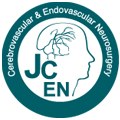- Apply for Authority
- P-ISSN2234-8565
- E-ISSN2287-3139
 ISSN : 2234-8565
ISSN : 2234-8565
Surgical considerations and techniques using intraoperative indocyanine green angiography for ethmoidal dural arteriovenous fistula
Cho Su-Hee (Department of Neurological Surgery, Gangneung Asan Hospital, University of Ulsan College of Medicine, Gangneung, Korea)
Kim Hong Beom (Department of Neurological Surgery, Asan Medical Center, University of Ulsan College of Medicine, Seoul, Korea)
Yang Ku Hyun (Department of Neurological Surgery, Gangneung Asan Hospital, University of Ulsan College of Medicine, Gangneung, Korea)
- Downloaded
- Viewed
Abstract
Objective: This study aims to investigate the efficacy of microsurgery with intraoperative indocyanine green (ICG) angiography as a treatment approach for ethmoidal dural arteriovenous fistula (DAVF).Methods: Between January 2010 and July 2021, our institution encountered a total of eight cases of ethmoidal DAVF. In each of these cases, microsurgical treatment was undertaken utilizing a bilateral sub-frontal interhemispheric approach, with the aid of intraoperative ICG angiography.Results: ICG angiography identified bilateral venous drainage with single dominance in four cases (50%) of ethmoidal DAVF, a finding that eluded detection during preoperative transfemoral cerebral angiography (TFCA). The application of microsurgical treatment, in conjunction with intraoperative ICG angiography, resulted in consistently positive clinical outcomes for all patients, as evaluated using the Glasgow Outcome Scale (GOS) at the 6-month postoperative follow-up assessment; six patients showed GOS score of 5, while the remaining two patients attained a GOS score of 4.Conclusions: The use of intraoperative ICG angiography enabled accurate identification of both dominant and non-dominant venous drainage patterns, ensuring complete disconnection of the fistula and reducing the risk of recurrence.
- keywords
- Ethmoid, Dural arteriovenous fistula, Microsurgery, Indocyanine green, Angiography
- Downloaded
- Viewed
- 0KCI Citations
- 0WOS Citations
